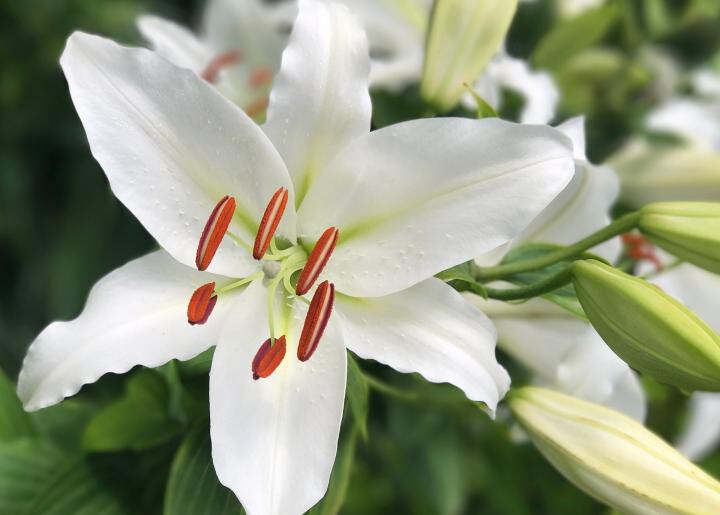Everyone loves lilies. With large, showy blooms, lilies add striking elegance to the yard and garden from early to midsummer. Grown from bulbs, lilies are perennial flowers that will return year after year and require minimal care, provided that you plant them in the right place.
Lilies have six plain or strikingly marked tepals (“petals”) and are often trumpet-shaped, sitting atop a tall, erect stem with narrow, long, lance-shaped leaves. They come in many beautiful colors, including pink, gold, red, orange, and white.
There are a number of popular lily species—and their endless hybrids—available to gardeners:
Asiatic lilies bloom first in early summer (in May or June), right after peonies. They are not fussy as long as they are grown in well-draining soil. They are the shortest type of lily (about 2 to 3 feet tall) and come in many colors, from pastel to tropical. They don’t have much of a fragrance, but they do add bright color to the garden.
Easter lilies are most commonly grown indoors as a holiday plant. As their name suggests, they are typically forced into bloom around Easter, in March or April. Outdoors, they are better suited for warmer regions of North America, where they can be planted in the garden after blooming has finished.
Oriental lilies have that famously strong fragrance. They are tall and stately (4 feet), and tend to grow more slowly, often blooming about the time when Asiatic lily flowers are fading (mid- to late-summer).
Trumpet lilies are similar to oriental lilies, producing many blooms with a nice scent. Their flowers tend to be smaller and more closed (like a trumpet) than those of the other lilies.
There are other lilies out there, of course, such as tiger lilies and Turk’s cap lilies, as well as hybrids like “Orienpet” (Oriental + Trumpet) and LA lilies (Easter + Asiatic). Browse through your favorite online gardening retailer’s catalog to find what you like best!
GET TO KNOW THE “TRUE LILIES”
There are many plants with “lily” in the name, but most are not what we call “true lilies.” True lilies grow from onion-like bulbs and are of the genus Lilium.
Daylilies (Hemerocallis spp.), despite the similar appearance of their flowers, are not true lilies. Daylilies have many leaves that grow from a crown, whereas true lilies generally have only one stem or shoot that grows from a bulb. Similarly, peace lilies, canna lilies, water lilies, lily-of-the-valley, and calla lilies are not true lilies either! Learn more about what makes a lily a lily.
WHEN DO LILIES BLOOM?
Lilies tend to bloom from early summer to fall, depending on the type. By carefully blending early, mid-season, and late varieties into your garden, you will enjoy their magnificent blooms from spring through first frost. At home in both formal and naturalistic settings, most lilies also take readily to containers. Plus, they make great cut flowers!

PLANTING
WHEN TO PLANT LILIES
In most regions, plant lily bulbs in the fall, a few weeks before the winter brings freezing temperatures. Bulbs planted in the autumn will have well established roots in the spring. The bulbs benefit from a winter chill to produce big blooms.
In areas with particularly harsh winters, we advise planting in the spring instead. Plant as soon as the threat of frost has passed.
Container-grown lily plants can be planted anytime during the early summer.
Buy the bulbs close to planting time. Because lily bulbs don’t go dormant, they will deteriorate over time, so don’t plan to buy bulbs in the fall and wait until spring to plant them.
CHOOSING AND PREPARING A PLANTING SITE
Select a site with soil that drains well. How can you tell? After a good rain, find a spot that is the first to dry out. Water trapped beneath the overlapping scales on the lily bulb may cause rot, so a well-drained site is essential.
Lilies need lots of sun. For dependable blooms, lilies need 6 to 8 hours of direct sunlight a day (aka “full sun”). If it’s too shady, the stems will attempt to lean towards the sun or get spindly and fall over.
Most of the popular varieties prefer acidic to neutral soil, but some are lime-tolerant or prefer alkaline soils (e.g., Madonna lilies).
Loosen the soil to a depth of 12 to 15 inches. The deep planting encourages the developing stem to send out roots to help stabilize the plant and perhaps eliminate the need for staking. Also, deep planting keeps lily bulbs cool when temperatures soar.
Enrich the soil with leaf mold or well-rotted organic matter to encourage good drainage. Learn more about soil amendments and preparing soil for planting.

HOW TO PLANT LILIES
Plant the bulbs 3 times as deep as the height of the bulb and set the bulb in the hole pointy side up. Fill the hole with soil and tamp gently.
Space bulbs at a distance equal to three times the bulb’s diameter (usually about 8 to 18 inches apart, depending on the variety).
For visual appeal, plant lilies in groups of 3 to 5 bulbs.
Water thoroughly at time of planting.